Pine trees are known for their longevity, with some species living for hundreds or even thousands of years. Understanding the average lifespan of pine trees is crucial for homeowners, landscapers, and forestry professionals who need to plan for the long-term management and care of these majestic trees.
What is the Average Lifespan of Pine Trees?

Pine trees generally have a lifespan ranging from 100 to 1,000 years, depending on the species and environmental conditions. However, this lifespan can vary significantly, with some species like the bristlecone pine living for thousands of years, while others, like the mugo pine, may only live for around 50 years.
How Long Do Longleaf Pine Trees Live?

Longleaf pine trees are known for their exceptional longevity, with some individuals reaching ages of over 450 years. These trees go through several life stages, including the seed, seedling, grass, mature, and old-growth stages. During the grass stage, they focus on developing an extensive root system, which helps them survive fires and droughts. Longleaf pines can grow up to 110 feet tall and typically cease height growth after 70-100 years.
What is the Lifespan of Different Pine Species?
The lifespan of pine trees can vary significantly depending on the species. Here’s a comparison of the lifespans of different pine species:
| Pine Species | Lifespan |
|---|---|
| Bristlecone Pine | Up to 4,800 years |
| Longleaf Pine | Up to 450 years |
| Lodgepole Pine | Up to 400 years |
| Scotch Pine | Up to 300 years |
| Mugo Pine | Around 50 years |
How Long Do White Pine Trees Live?
White pine trees, specifically the Eastern White Pine, can live for around 450 years. They are known for their tall stature, reaching up to 150 feet, and are often used for timber and landscaping.
What Factors Affect the Lifespan of Pine Trees?
Several factors can impact the lifespan of pine trees, including:
- Environmental Conditions: Climate, soil quality, and sunlight exposure all influence a pine tree’s lifespan. Trees grown in harsher climates tend to live longer than those in warmer climates.
- Diseases: Canker disease, rust, and other diseases can significantly reduce a pine tree’s lifespan if left untreated.
- Pests: Bark beetles and soft scale insects are common pests that can harm pine trees and shorten their lifespan.
- Human Activities: Urbanization, air quality, and root damage can all contribute to a shorter lifespan for pine trees.
Why Do Pine Tree Lifespans Vary by Species?
The lifespan of pine trees varies significantly by species due to differences in growth rates, environmental adaptations, and resistance to diseases and pests. For example, the bristlecone pine can live for thousands of years, while the mugo pine has a much shorter lifespan.
References:
– https://www.groundsguys.ca/blog/2017/january/tree-of-the-month-pine/
– https://www.hunker.com/12474232/what-is-the-life-span-of-pine-trees
– https://longleafalliance.org/what-is-longleaf/the-tree/life-stages/
